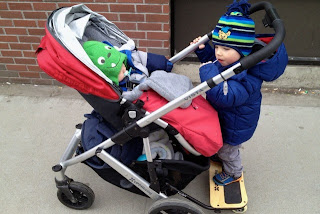Today I’m going to deviate from my typical “dog training” topic into the realm of “child training” or “teaching” as it is typically referred to! In my previous life (really, up until December) I taught children with dyslexia how to read and write using the Orton-Gillingham method. As I moved through my Masters program in Applied Behavior Analysis I came to realize that the reason that method is so successful is that it really is based on sound behavioral methodology. During that time I also learned about TAGteach essentially, using applied behavior analysis in the form of clicker training to teach people. Now I also have my own children and am constantly considering the principles and methods of behaviorism when raising them.
No Risks
Shaping
In this case, the terminal behavior was stepping onto the roller board, holding onto the stroller, and staying on for a reasonable duration of time. (Reasonable is a bit undefined, but it changes depending on where we are going.) I used freeze-dried blueberries as the reinforcer as they are currently a hot favorite in our house. I didn’t use a clicker in this instance, but he received a verbal marker (good job! or other variations) and a blueberry while still in position immediately after performing to criteria.
Criteria for Reinforcement
- Putting one foot on the stationary board. (His dad modeled this twice and was given a blueberry each time, that was the last piece that was modeled.)
- Putting two feet on the stationary board.
- Holding onto the stroller with two feet on the stationary board for 5 seconds.
- Holding onto the stroller with two feet on the board while moving for 5 seconds.
- Holding onto the stroller with two feet on the board while moving for 10 seconds.
- Holding onto the stroller with two feet on the board while moving for 15 seconds.
- Holding onto the stroller with two feet on the board while moving for one entire city block.
Reinforce Kids with Food Treats? Really?
Many people are uncomfortable with reinforcing their children with food, but really- what were my alternatives here? As I see it, I could have done these:
- Held him on the board until he “got used to it”
- Waited six months until he understood the “rule” about standing on the board.
- Given up.
Wasn’t shaping it using a handful of dried fruit a better option? My relationship with my son is healthy and happy; Oliver played a fun game and got to eat something he loves (and is even healthy!); and rather than six months of pushing around an extra stroller seat, we now have a functional option to walking. Hurray!
Behavior Analysis = Happy Relationships
So no, this is not a parenting blog or a teaching blog- but it is a blog about behavior and that extends well beyond dogs. It impacts every relationship in our lives and everything we want to teach to any organism- be it child, dog, or goldfish. As such, I just wanted to share how I use applied behavior analysis in my day-to-day life to make it easier, less confrontational, and more positive.
Adria is a Board Certified Behavior Analyst and owner of Click'n'Treat Dog Training LLC
adria@clickntreattraining.com
Do you ever wonder what your older kids REALLY want as reinforcers? To find this out, TAGteacher Lynn Loar asked them (huh!). Click here to read what the kids told Lynn




